Claire Mabey – 23 August, 2017
I left City Gallery feeling confused. My own questions were dominating an internal and circular conversation that needed many other voices. The framing of 'On Going Out with the Tide' presented us with a problem: the conversation arranged between McCahon, history and contemporary ideologies disappeared into a void. The exhibition was driven by love and respect for McCahon. I can see why they wanted to offer him a retrospective and try to place him into a contemporary space: so we could see it too.
Wellington
Colin McCahon
On Going Out with the Tide
Curated by Wystan Curnow and Robert Leonard
8 April - 30 July 2017
I have been writing this review for months. Starting, getting to the end, turning back, deleting, starting again. Pausing. Stopping altogether. Almost pressing send on the ‘I don’t think I’m the right person to write this’ email to the editor. But On Going Out with the Tide refused to let me go. Consequently review is (a) super late; and (b) a highly concentrated and convoluted bundle of thoughts (…you are welcome).
Most of the time I reckon the best way to look at a painting is to look through your own eyes and enjoy the complicated set of references and ideas that the image or object will trigger in you. That’s definitely one way to go about On Going Out with the Tide. The thing is, I couldn’t start or end there with this one. The exhibition tangled me up in a way that I did not anticipate. McCahon after Sherman felt strange to being with. Then I had a chance coffee with Wystan Curnow. Two hours of conversation that might have finished this review for good: there was already so much to unpack. However, three thoughts crystallised as a result of that encounter: there is an intergenerational dissonance when it comes to McCahon; there is huge complexity attached to attempting to make the historical relevant in a contemporary space; and who is Colin McCahon to me, anyway?
McCahon was my artist model for School Certificate Art in the year 1999. The lifeless, bland landscapes I pasted up onto boards at 3am the day before the portfolio was due haunt me to this day. The McCahonian aesthetic has occupied my imagination and education so thoroughly, that looking past and around him needs concerted effort. In a wider sense, McCahon is still the artist to get past, get over, get around. The Canoe Tainui sold for $1.35 million in 2016. Today the immensity of that million dollar presence can be as much of an obstacle as it is also seen a testimony to value. Like Mondrian was for McCahon, so McCahon is the towering canvas, ‘regarded as New Zealand’s most important modern artist’ (Wikipedia). On Going Out with the Tide felt like an attempt to re-assert that statement. It presented McCahon at the centre of a great shift: a time when a growing understanding of biculturalism was expressed through contemporary art. The exhibition revealed McCahon’s experiments with new languages and systems of belief, and with events relating to Māori land rights. Curator Robert Leonard wrote, “On Going Out with the Tide is a research project. We intend it to be a platform for ongoing discussion, both about McCahon’s work and about the ways the cultural landscape it occupies has shifted.”
My conversation with Wystan (who being very patient and generous with his enormous depth of knowledge, placed my already tiny dinghy into an even larger ocean of thought) threw the framing concept of ‘research project’ into greater relief. I had felt that the exhibition was missing in conversation and there was a sense of isolation that lingered that was problematic for me. The conversation affirmed just how much On Going Out with the Tide presented for the curators the opportunity to just begin covering ground that hadn’t been fully explored before. And there was a sense of great task and purpose to this, which can be seen when you look through the many-armed embrace of public programming around the exhibition. So, the exhibition wasn’t the final thing, or the only thing—it was part of an ongoing investigation. I confess I didn’t get to much of the public programming and my experience was just what I saw and read on the walls and in the exhibition guide. The question is then, is it fair to judge the show in isolation, without taking into consideration all of the conversations that occurred around it? Many people, I think, would have seen the show without accessing the public programme opportunities. And aside from my luck with one of the curators, for the purposes of this review, I decided to write from that perspective, too.
To me, City Gallery needed to be a place where artists get past McCahon, or at least speak to him. There was an absence of voices that could have enhanced or challenged ‘the cultural landscape that McCahon occupies.’ Perhaps because this was a ‘research project’ it felt unfinished. The exhibition was zeroing in on McCahon’s conversation with New Zealand and nobody was able to talk back or join the discussion. A lot of this came down to age. I think intergenerational dissonance is a big part of McCahonian discussion today: for many among the older generations he was ‘New Zealand’s most celebrated artist’ and for some among the younger generations he may still be, but I’m not sure we are all content with that idea.
That handwriting. On Going Out with the Tide was full of words. So much of McCahon’s visual identity is tangled up in those looping letters. The documents gallery presented primary documents and ephemera that extended the ruminations happening on the walls. McCahon was a robust writer, energetic and earnest: he described his view on the colonisation of Taranaki, the invasion of rhododendrons, ‘daffodils and chalets and muck’ in a letter to Ron O’Reilly in 1977. There was a copy of The Tail of the Fish: Maori Memories of the Far North by Matire Kereama, which influenced so much of his thinking and output of this period. In a letter to John Caselberg in 1968 the McCahon hand has drawn a koru and within it underlined the words ‘This is just what it / looks like a penis / and not a curled fern frond’. And towards the end of that letter he grapples with the idea of what it means to be a New Zealand artist, a Māori artist, a regional artist: ‘They have a world I’ve tried to make, (to make — to get with) at their fingertips and I’ve got a world they want at mine—we don’t allow each other, all prohibitions and ‘not telling’.’ On another page, after signing off, he says ‘I feel all bent up with the weight of the Urewera mural’.
The documents gave us more of McCahon than ever before. The paper and real handwriting, sometimes hard to read, pulled him back from the contemporary art space in which we are surrounded and back into the context within which he was alive and contemporary. I found the documents to be a conundrum: on the one hand illuminating, in that we can sense the voice of the curious and searching artist; and on the other hand irritating and tiresome (the unequivocal statement that the fern is actually a penis). Part of McCahon’s weight is his dominance as a male on the New Zealand art historical timeline. I know that for many these documents were thrilling. Most people I talked to who felt that way possess a memory of time that overlapped with McCahon the contemporary artist.
In Gallery 1 the McCahonian koru wended its way through the paintings in this gallery, starting with Now is the Hour, 1962. There was nothing completely static in these shapes or in the spaces they existed in. All of the evidence of the painter experimenting was there. In Koru 1, 2, 3 the one was a solitary figure, while the two and three were created from the outside of the frame, a koru on a thin pole being pushed into the centre of the canvas as if being held there for a moment—until they were whipped away and thrust together in a different formation on another black canvas somewhere else. The effect was of trial: of finding a way to fit the shape into another language. The ‘one’ felt familiar in McCahon territory: swarthy and assertive of the one, the I, the only. It made me think of the Days and Nights series from the early 70s. There was always something about that repetition and reassertion of the idea of ‘I’ that suggested masculine vulnerability: the need to single out and create majestic and monumental solitude. To have one power over a landscape, over a space.
And there on the caption was the note that ‘McCahon thought of the koru as phallic’. (What do people think about this? I really want to know. How do Māori feel about this interpretation?) McCahon’s experiments with koru were an attempt to incorporate new languages—that he saw as essential to the place he was in—together. Presenting the painting with this statement was fascinating, but here was a chance to offer the contemporary view on this historical statement. And it wasn’t there.
The Caltex commission spoke to a failure in McCahon’s experimentations. These canvases were awkward: the languages didn’t work together and felt forced into a shape that didn’t sit comfortably on the canvas.
Io, 1965 was McCahon’s attempt to bring his numerical language into the same landscape as Io Matua Kore. The letters existed in smoky, shifting heights above a tunnel of black. They looked at once like they were being shunted out of the universe by a void and as though they were the guardians of that empty nothingness. McCahon’s signature was a wedge of light in the lower right-hand corner. Again this work felt like an assertion, a discovery: absorbing a Māori world view into his own aesthetic. The painting felt almost triumphant in its depiction of the unknown overwhelming the universe. The concept of ‘Io’, I read, is the supreme being in Māori metaphysics and may have been, for some tribes, a response to Christianity. For McCahon this concept of a monotheistic universe would have been in sympathy with his Christian memory. It was easy to translate, easy to find a coincidence. I could see how he had arrived here.
The question is whether this was an appropriate confluence of ideas, given the weight of his spiritual knowledge was heavy on the Christian side. Those stories, images, symbols are tentacular, reaching to the very back of his experience and of his collective, European heritage. Io on the other hand is new, sacred knowledge that needs to be understood in multiple ways (language and commitment to understanding the entire spiritual system that it belongs to). The weight of McCahon was heavy over the void that he created in ‘Io’: many other voices were echoing around inside it and getting louder as the show moved on in time.
In Gallery 2, the million dollar painting, The Canoe Tainui, 1969, was an eight-panel board that called out the whakapapa of the Tainui waka, an incredibly sacred object in Māori history and mythology. It was an impressive painting but I felt like I didn’t have the knowledge to analyse its impact: I sensed the voices and read the names. I read the McCahon letter that says ‘All this is permeated with a certain horny symbolism’ and I wanted to know what he meant. And I also read ‘Had a tryout on this last Saturday. Very mixed. One said “I know Arthur and Bella.” Others just shocked.’ and I wanted to know what that refers to.
On Going Out with the Tide, 1969, called for us to ‘SING’ on each panel of the triptych. The word ‘Io’ stood out among the text, catching the eye as you moved to the looser, more fluid passages. This relationship between word, sound and pace was more successfully depicted in The Lark’s Song, 1969. This was a larger scale, one-panel work with Māori text painted in varying opacities in that handwriting. A dotted lined ran down to the right of centre, and small u-shapes ran horizontal in the upper half. Strong downward strokes emphasised ‘I’ and several ‘K’ letters and the paint was stronger, thicker towards the bottom right of the canvas.
At the bottom in all caps was the phrase ‘can you hear me St. Francis’. A scrubbed pair of white clouds floated in from the edge of the canvas on the upper right. The words are lyrics from Matire Kereama’s book The Tail of the Fish: Maori Memories of the Far North (1968). The line about St Francis is from a Peter Hooper poem (I’d recently read Steve Braunias’ very beautiful writing on Peter on the SpinOff). At first view the painting was as shifting as the bird: the movement across lines and texture, the draw of the words as they take your eye from top down to bottom and back up to the floating clouds. Again McCahon seemed to be confident revelling in new knowledge, bringing languages together and pinning them back to the stories that he knew deeply (St Francis). But reading that the lyrics are meant to be sung aloud, as a game, because when done right the song mimics the sound of the bird, made me feel like I was missing half of the work. I would have loved to hear the song and watch the painting to see where they join. Apparently this did happen on the last day of the show and I was sorry to have missed it. That is the kind of extension that would have made this exhibition feel more at home in a contemporary gallery.
Moby Dick Is (Was) a Volcano c. 1971-3 gave us another kind of McCahon. The charcoal drawing looked like a map: the artist revealing the discoveries he’s made across the landscape in front of him. There was a playfulness here, something of the children’s writer plotting out and setting potential sites of action. The optimism of Tui Carr Celebrates Muriwai Beach, 1972 explained it. Tui is Colin’s beloved grandson and this painting celebrated the moment that he and Colin together embraced the magnificent landscape, McCahon’s Moby Dick in the distance the shape of Ohia Island. McCahon’s own internal mythologies and personal histories have imprinted on the New Zealand landscape. It struck me particularly powerfully in this gallery how phenomenally dominant McCahon’s aesthetic had been on my own internal slide show, and how vulnerably lacking and how circular our own reference points can become. McCahon was landscape in my fifth form art class. So much has come into my sight and challenged that encounter since that time, but here McCahon was again, an extraordinarily powerful marker of time.
Gallery 5 holds Am I Scared, 1976, The Parihaka Triptych, 1972 and The Urewera Triptych, 1975, A Poster for the Urewera No. 1, 1975, A Poster for the Urewera No. 2, 1975 and A Song for Rua, Prophet (Dreaming of Moses), 1979. The trauma that these works related to was overwhelming. And in many ways the heart of this show was in this room where conversations about our history, or lack of them, looked at us from the walls. McCahon came across as very earnest in his attempt to try to express a theft, violence and loss that was beyond his experience. The Urewera Triptych is part of the story of injustice to Tuhoe and a response by McCahon who said ‘I’m a part of it all but can’t be part of it. I wish I could belong.’ There was the bold thrust of light up the centre of the canvas splicing the dark land that is populated by words for the people of the land.
By this time the presence of McCahon in the context of this time period and the exploration of biculturalism made me acutely feel the absence of other voices. I wanted to see and read other artist’s reactions from the same moments in history, alongside these works so that a conversation was actually taking place. I wanted contemporary reactions and contemporary conversations. For me this show was starting to feel like a paradox: McCahon was trying to learn and reflect back his version of New Zealand differently with the new information now incorporated, but this gallery was placing him impossibly at the centre of the contemporary questions, voids and all.
The Urewera Posters were luminous. In a predominantly monochrome palette the sunset colours almost looked crazed, euphoric. The confluence of Christian and Māori ideas were elevated with colour and an embrace: in Poster for the Urewera No. 2 Rua the Prophet and the Tuhoe people were encircled by luminous dots and headed and footed by crosses. McCahon was uplifted by the Christianity in common: like the dribble of paint that links the ‘t’ of the and the ‘l’ of people, a cross and an I.
I left City Gallery feeling confused. My own questions were dominating an internal and circular conversation that needed many other voices. The framing of On Going Out with the Tide presented us with a problem: the conversation arranged between McCahon, history and contemporary ideologies disappear into a void. The exhibition was driven by love and respect for McCahon. For many he was and still is the most important New Zealand artist. I can see why they wanted to offer him a retrospective and try to place him into a contemporary space: so we could see it too.
The problem for me was that the exhibition didn’t achieve that. Instead I think On Going Out with the Tide got stuck. Intergenerational dissonance is a timeless tension: I don’t expect anyone to agree with me, but I suspect that other younger viewers who have their own ideas about New Zealand’s most important artist might have felt similarly. McCahon certainly shaped the conversation in the 60s and 70s, but I’m not sure if this exhibition has moved that conversation on any further. For me, it needed to have contemporary artists and voices who could speak directly to relevant experience, placed right alongside McCahon so we could see a conversation play out. That would have, I think, truly offered a contemporisation and the ultimate nod of respect by asking: how do you get past McCahon?
Claire Mabey
Recent Comments
Mary-Jane Duffy
Taking up Claire's point that the conversation with McCahon moved no further on... Shannon Te Ao's video work was on ...
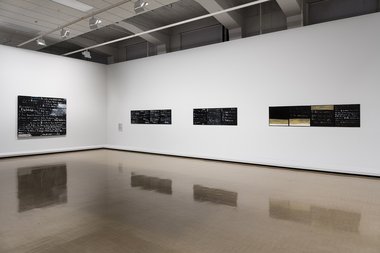

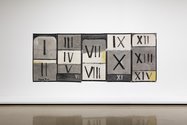
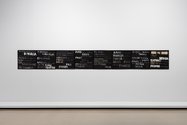
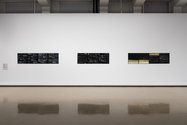
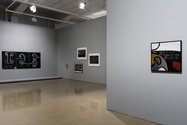
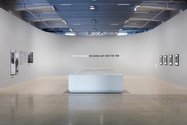

 Two Rooms presents a program of residencies and projects
Two Rooms presents a program of residencies and projects Advertising in this column
Advertising in this column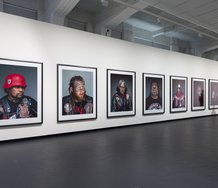
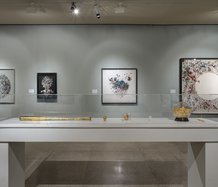
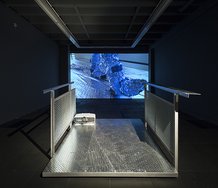

This Discussion has 1 comment.
Comment
Mary-Jane Duffy, 3:47 p.m. 31 August, 2017 #
Taking up Claire's point that the conversation with McCahon moved no further on... Shannon Te Ao's video work was on in the cinema at the same time as the McCahon exhibition at City Gallery. It represented a metaphor for the absence--the impossibility--of any conversation. The work suggested an outsider peering into the doors and windows of the McCahon house at Titirangi and messing about on the deck, but all the time with an ear out for the sound of someone returning...
Participate
Register to Participate.
Sign in
Sign in to an existing account.